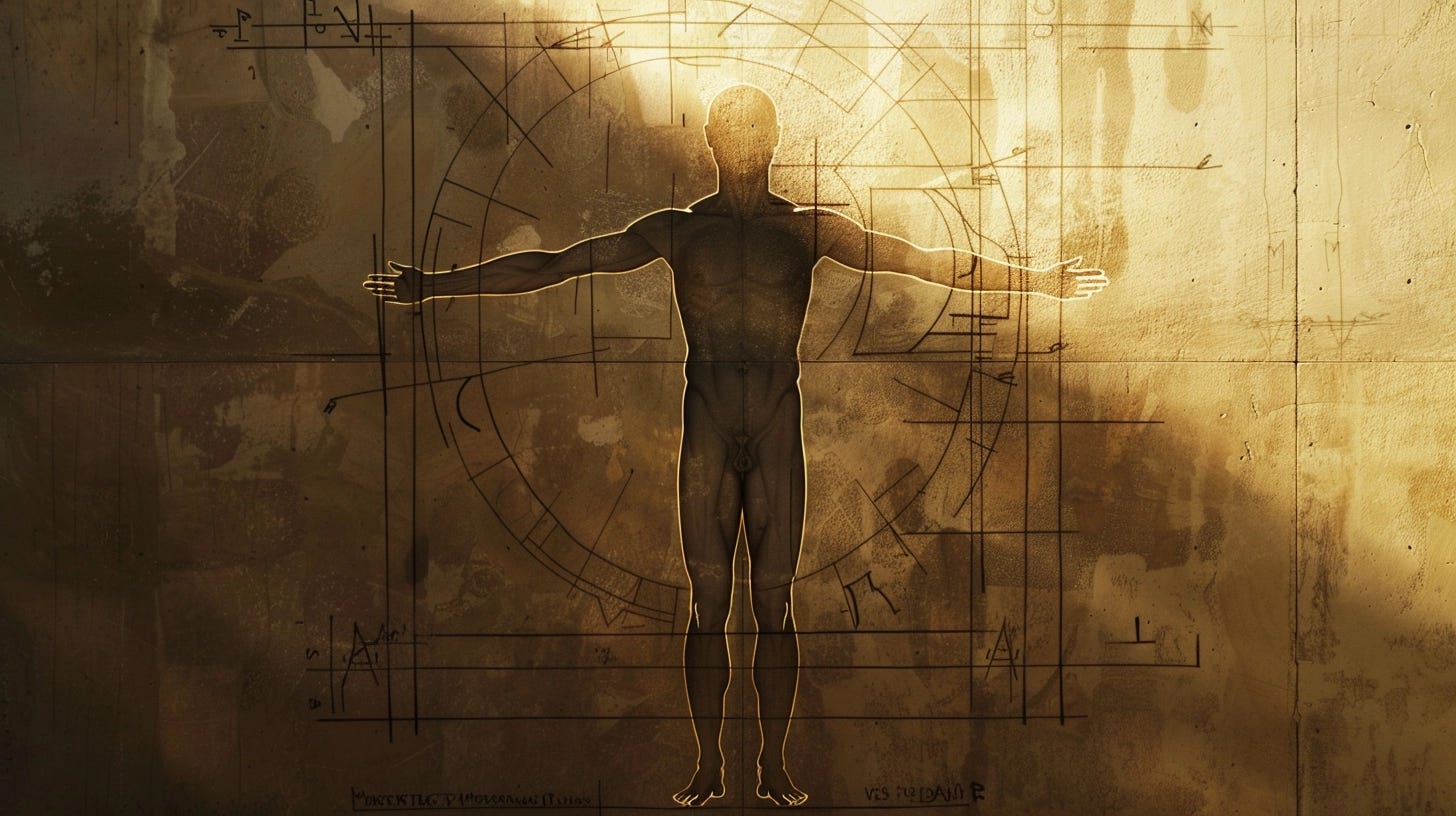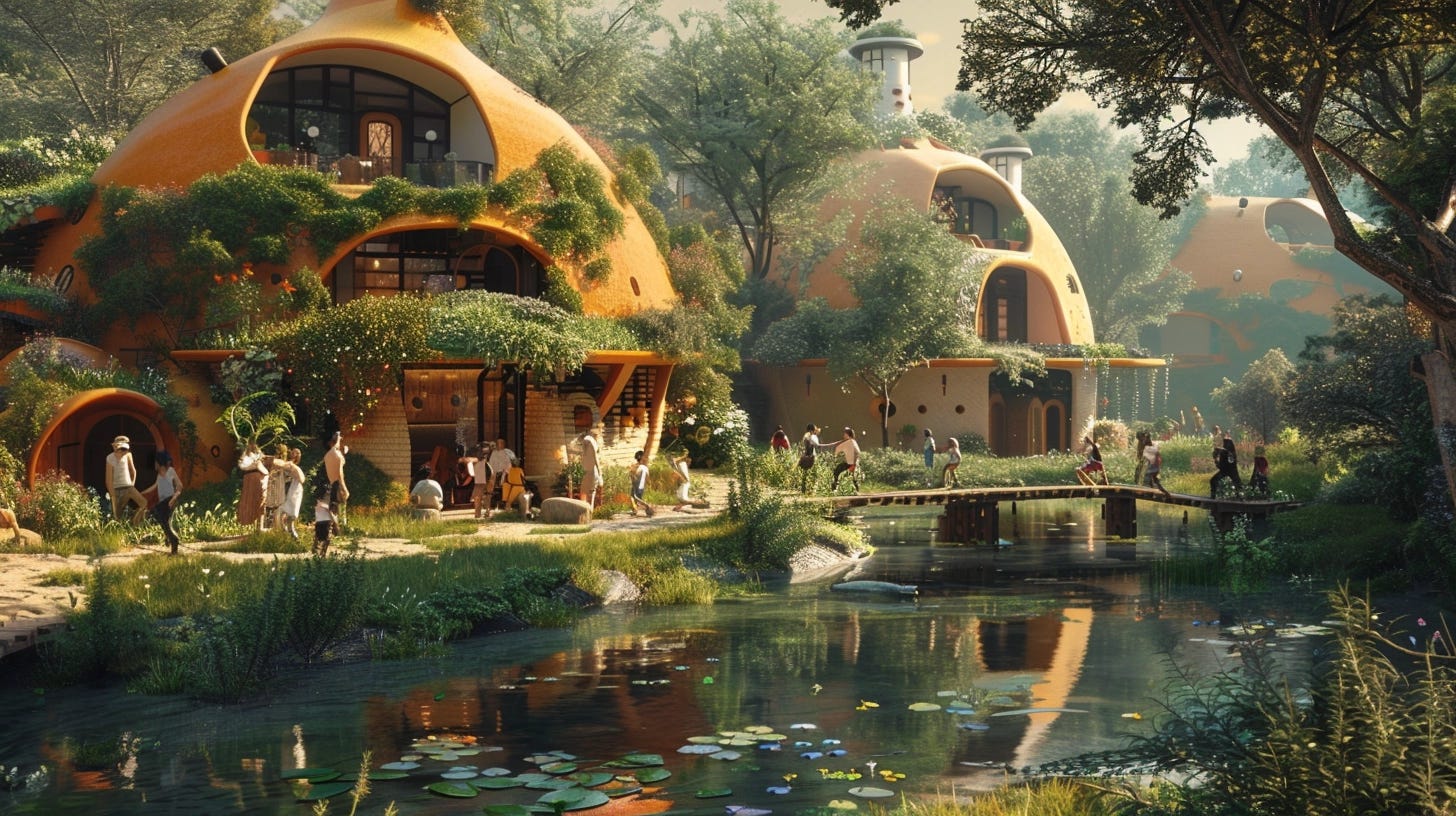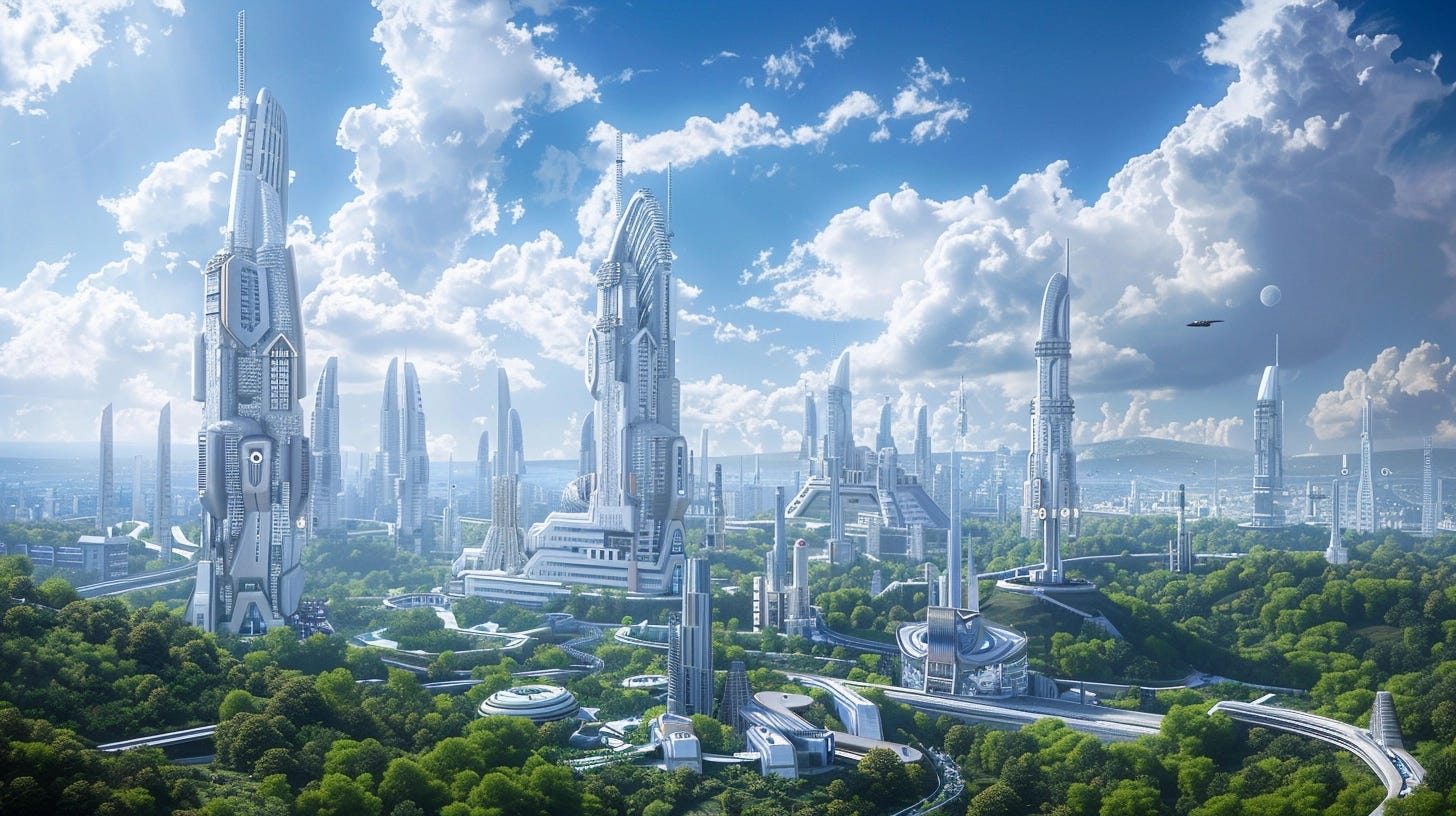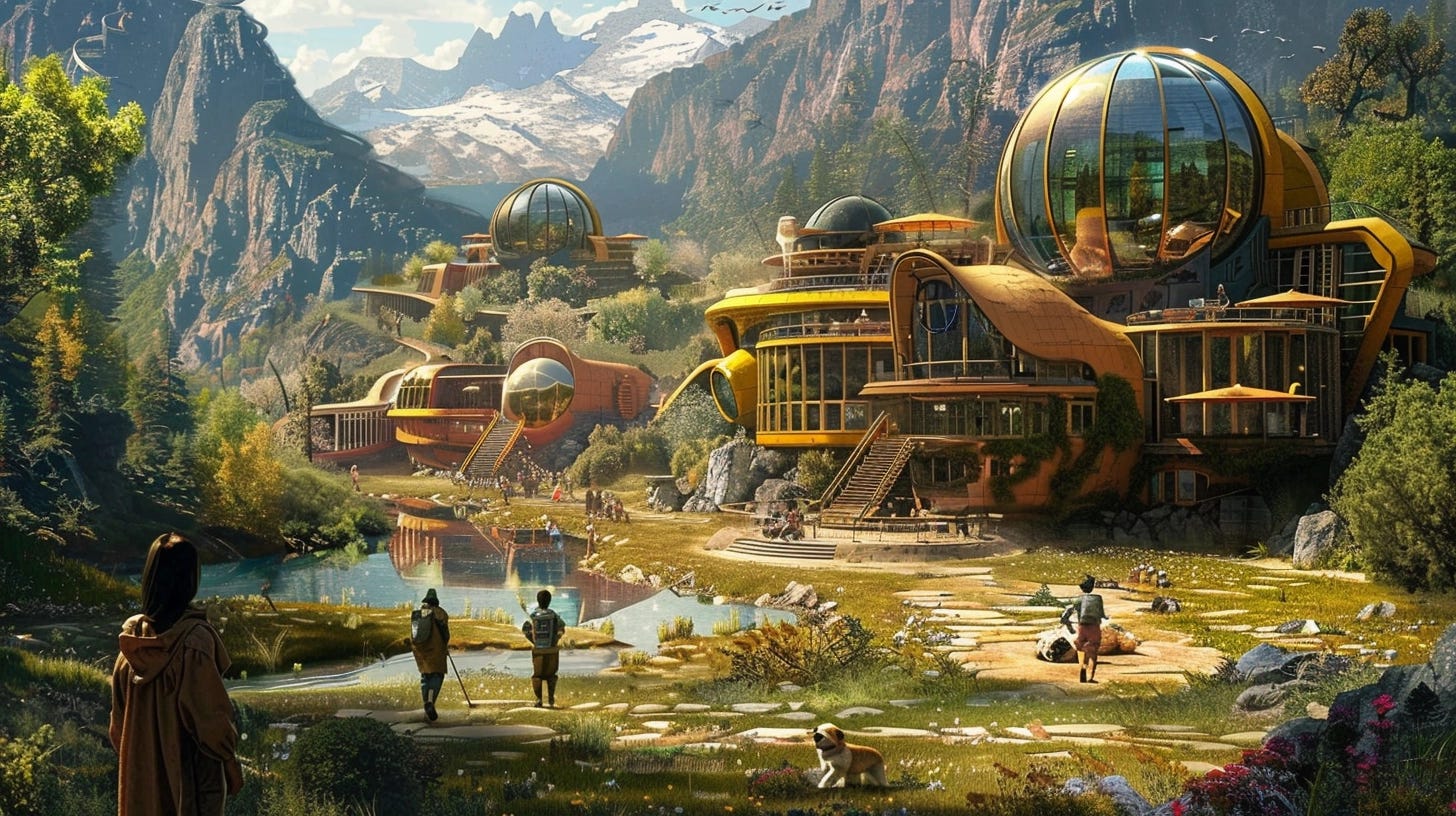Radical Alignment: Why We're Miserable (and how to fix it!)
Embracing universal human truths to overcome the Nihilistic Crisis (TLDR at the very end)
Introduction to Radical Alignment
In recent years, a pervasive sense of despair has crept into the collective consciousness. From the existential dread of climate change and AGI, to the isolation of the loneliness epidemic, many people, particularly young adults, find themselves grappling with a profound sense of meaninglessness and disconnection. The symptoms of this malaise are all too familiar: rising suicide rates, deaths of despair, and a cynical, fatalistic outlook on the future. Gen Z has been disproportionately impacted.
These experiences, while undeniably widespread, often feel insurmountable and intractable. Movements like antiwork have emerged as attempts to counter the systemic forces that contribute to our misery, but they often fail to articulate the deeper philosophical roots of our predicament. As a result, we find ourselves reaching for Band-Aid solutions, such as new antidepressants or self-help trends, that fail to address the fundamental causes of our distress. Not even psychedelic assisted therapy can overcome systemic aberrations.
The truth is, the problems we face are not merely individual or even societal, but rather structural and intergenerational in nature. They are the downstream effects of a nihilistic worldview that has permeated our culture, eroding our sense of meaning, purpose, and connection. This nihilism is like a Leviathan emerging from the depths of our collective psyche, a monstrous force that seems to defy understanding and resist all attempts at confrontation.
And yet, despite the apparent inscrutability of this existential threat, we must not resign ourselves to despair. For beneath the surface of our malaise lies a deeper truth about the human condition, a truth that offers a way out of the abyss of nihilism and towards a more authentic, fulfilling way of being in the world.
In this article, we will embark on a journey to uncover this truth and explore a new philosophical framework for living in the face of nihilism. I call it Radical Alignment, which is part of a larger framework of Postnihilism. We will begin by tracing the roots of our current predicament, examining how the nihilistic worldview has shaped our culture and our individual lives. From there, we will delve into the concept of Radical Alignment, a powerful alternative to optimistic nihilism that offers a path towards meaning, connection, and wholeness.
By the end of this exploration, you will have a deeper understanding of the forces that have shaped our world and a toolkit for navigating the challenges of existence in the 21st century. You will see that, far from being a cause for despair, the crisis of nihilism is an invitation to radically align ourselves with the fundamental truths of human nature and to create a world that honors our deepest needs and aspirations.
So let us begin this journey together, with open minds and hearts, ready to confront the Leviathan of nihilism and emerge on the other side with a renewed sense of purpose and possibility.
The Roots of Nihilism: Science, Cognitive Dissonance, and the Democratization of Information
To understand how we arrived at this juncture, we must examine the three primary forces that have shaped the intellectual and cultural landscape over the past five centuries: human curiosity, cognitive dissonance, and the democratization of information.
At the heart of the human experience lies an insatiable curiosity, a desire to understand the world around us and our place within it. This curiosity manifests itself in the pursuit of science and technology, the relentless drive to uncover the mysteries of the universe and harness that knowledge for practical ends. From the Scientific Revolution of the 16th and 17th centuries to the rapid technological advances of the modern era, this force has been a constant engine of change and discovery. There are plenty of evolutionary reasons that we are curious, so I characterize our curiosity as intrinsic, innate, and instinctive. It is an immutable aspect of humanity.
Yet, as our understanding of the world has grown, so too has the potential for cognitive dissonance. As we uncover new truths that challenge our existing beliefs and assumptions, we are confronted with the uncomfortable tension between what we now know and what we have long held to be true. This tension is deeply unsettling, and we are driven by a powerful psychological need to resolve it, either by adapting our beliefs or by finding ways to dismiss the new information. Every culture and subculture has different ways of reconciling cognitive dissonance. Some people argue and shout online, others sweep it under the rug. But in the long run, this intrinsic force of mind demands reconciliation. From one generation to the next, we try to alleviate cognitive dissonance. “Kids these days” shirk the responsibilities that their elders believe they should have, they rebel, and this is just one way that cognitive dissonance works itself out of over time. Unfortunately, this almost means questioning everything - but the overarching point is that we want to achieve internal consistency over time. Which means any worldview or model that fails to do so will eventually be deconstructed.
The third force at play is the democratization of information, which has been accelerated by a series of technological innovations. The invention of the printing press in the 15th century marked a turning point in human history, making it possible for ideas to spread rapidly across geographic and social boundaries. Subsequent developments, such as radio, television, and the internet, have only amplified this trend, creating a global marketplace of ideas where competing worldviews can clash and intermingle. Cognitive dissonance has been amplified, and now it seeks resolution.
The convergence of these three forces has had a profound impact on the intellectual and cultural frameworks that have shaped human society. The pursuit of scientific knowledge has challenged traditional religious and philosophical beliefs, while the spread of information has exposed people to a wider range of ideas and perspectives than ever before. As a result, the once-solid foundations of meaning and purpose have been gradually eroded, leaving many people adrift in a sea of uncertainty and doubt. From a mathematical perspective, these forces have increased the perturbations and entropy in the human information landscape: shaking things loose and forcing our epistemic models to become more sophisticated.
This process has been ongoing for centuries, but it has accelerated in recent decades with the rise of globalism and internet - resulting in the shift from modernism to postmodernism. Modernism, with its emphasis on reason, progress, and individualism, sought to break free from the constraints of tradition and forge a new path forward. Postmodernism, in turn, questioned the very notion of objective truth, arguing that all knowledge is socially constructed and that there are no universal narratives or absolutes.
While these intellectual movements have brought about significant social and political changes, they have also resulted in a growing sense of nihilism and disillusionment. It’s important to recognize that these “movements” were not deliberately constructed, like the Civil Rights Movement, but rather, were the natural evolution of intellectual, philosophical, and social trends. As the old certainties have crumbled away, many people have been left with a profound sense of emptiness and despair, a feeling that life is ultimately meaningless and that there is no inherent purpose or value to human existence. This is why commentators like Seraphim Rose and Jordan Peterson decry the “moral decay” of today.
This is the backdrop against which the current crisis of meaning and connection has emerged. It is the product of centuries of intellectual and cultural upheaval, driven by the inexorable forces of human curiosity, cognitive dissonance, and the democratization of information. These forces combined to create an inexorable slide towards deconstruction and even disintegration. Traditional notions of right and wrong, of the “good life” have come under intense scrutiny, and in some tragic cases, have been categorically rejected, much to our own detriment.
The Nihilistic Crises of the 20th Century
The last century saw some of the worst crises of human failure and failures of consciousness in history, manifesting in the form of multiple world wars, the rise of totalitarian regimes, and the specter of nuclear annihilation. At the same time, this period also witnessed the ascendancy of capitalism, globalism, and neoliberalism, which have had a profound impact on the way we live and think about ourselves and the world.
Technology played a crucial role in these developments, facilitating everything from industrialized warfare to global interconnectedness. While technology has undoubtedly brought many benefits, it has also created new affordances and incentive structures that have shaped human behavior in profound ways. Financial technologies, such as complex investment instruments, have led to economic instability and inequality, while political technologies, such as social media, have been used to manipulate public opinion and undermine democratic institutions. Edward Bernays would be proud of what Meta has achieved - empowering everyone with a pocketbook or an internet connection to become a state propaganda actor!
Over the past century, these various trends have conspired to create a world that is increasingly organized around the principle of economic productivity above all else. The dominant metric of success has become GDP growth, and nations, corporations, and individuals alike have been compelled to optimize for this narrow goal at the expense of other values and considerations. Corporations have more economic agency than you! They are given white-glove treatment by the governments while your taxes go up, and you, as the working class, get fleeced more and more every year.
While this focus on economic growth has led to significant improvements in material living standards, it has also had a dark side. We live in a period of material abundance, but spiritual bleakness. Almost everyone has abundant food, TV, and even air conditioning. But your worth as a human is tied to your wallet. You are only valuable so long as you are valuable to the company. The relentless pursuit of efficiency and productivity has led to a culture of overwork and burnout, as people are forced to sacrifice leisure time and other aspects of a well-rounded life in order to keep up with the demands of the market. Side gigs, hustle culture, and struggling to make ends meet with full time work have become the norm.
This is where the influence of nihilism can be seen most clearly. The nihilistic worldview, which holds that all values are relative and that individuals are free to pursue their own subjective desires, has created a moral and philosophical vacuum that has been filled by the imperatives of the market. The idea that there is no inherent meaning or purpose to life has been used to justify the pursuit of narrow economic interests at the expense of other human values. Nihilism was an incredibly convenient narrative, which has been seized upon by corporations, billionaires, and nations. The moral hole left by nihilism, and the idea that an individual has absolute control over their own destiny, has been gladly backfilled with values of loyalty to the corporations (look at the cult Apple has built) and the Protestant work ethic that if you’re not working, you are profane, lazy, and sinful. Poverty is shameful in America, particularly in Christian America. Didn’t Jesus say to love thy neighbor and how you treat the least of you is how you treat me?
All of America, from our individual lives, to the adverts we see, to state and federal policy, are organized around the principles productivity. Ideally, we are free to explore whatever lifestyle we wish, so long as we have the dollars to do so.
The result has been a profound sense of alienation and disconnection, as people are left to navigate a world that seems increasingly devoid of meaning and purpose beyond the accumulation of wealth and status. The promise of freedom and self-determination held out by nihilism has proven to be a hollow one, as the forces of consumerism and advertising have conspired to keep us trapped in a cycle of endless consumption. Money as become the means and the end, rather than just the means to a different end. Even worse, consumerism (which was very deliberately created through propaganda) keeps you on the productivity treadmill.
This is not to say that there haven’t been benefits to the rise of capitalism and globalism. The creature comforts we enjoy today, such as air conditioning and on-demand food, are a testament to the power of markets to drive innovation and improve living standards. However, the price we have paid for these material gains has been steep, and it is becoming increasingly clear that we need a new philosophical framework that can help us navigate the challenges of the 21st century.
The nihilistic crises of the 20th century have left us with a world that is deeply out of balance, where the pursuit of economic growth has trumped all other considerations. As we grapple with the consequences of this worldview, it is clear that we need a new approach that can help us align our economic activities with our deepest values and aspirations. This is where the concept of Radical Alignment comes in, offering a way forward that honors the complexity of the human experience and seeks to create a world that is more meaningful, fulfilling, and sustainable for all.
The Four Abandonments: The Vicious Cycle of Nihilism
At the heart of the current nihilistic crisis lies a vicious cycle that I call the “Four Abandonments.” This cycle begins in childhood and repeats itself throughout an individual’s life, reinforcing a sense of hopelessness, despair, and existential terror. By understanding these four abandonments - childhood abandonment, social abandonment, cosmic abandonment, and self-abandonment - we can begin to grasp the true nature of the nihilistic crisis and the challenges we face in overcoming it.
Childhood Abandonment: The Roots of Distrust and Anxiety
The first abandonment occurs in childhood, and it is perhaps the most insidious and damaging of the four. In recent decades, we have seen a rise in phenomena such as latchkey children, who are left to fend for themselves while their parents work long hours, and children who are raised primarily by screens, whether it’s tablets, smartphones, or video games. This lack of consistent, attentive parenting has profound effects on a child’s emotional and psychological development.
One particularly troubling trend is the practice of “sleep training,” which involves leaving infants to cry themselves to sleep without parental intervention. While proponents of this method argue that it teaches children to self-soothe and become independent, the reality is that it can lead to feelings of abandonment and insecurity that persist into adulthood. It is quite simply unnatural.
The effects of childhood emotional neglect (CEN), a form of abandonment that occurs when parents fail to respond adequately to a child’s emotional needs, have been well-documented by researchers. Children who experience CEN are more likely to struggle with anxiety, depression, and low self-esteem, and they may have difficulty forming healthy relationships later in life. They may also develop a nihilistic or fatalistic outlook, believing that the world is a cold, uncaring place where they are ultimately alone and unsupported.
Remember, mommy and daddy have to get up to go to work, so it’s imperative that children learn to entertain themselves. Physical unavailability is the same as emotional neglect. We humans are not wired to be left alone for long periods of time. We are wired to surrounded by lots of people that we love and trust at all times. Any deviation from that is a form of harm, deprivation, and abandonment.
Social Abandonment: The Isolation of Modern Life
As children grow into adults, the patterns of abandonment they experienced in childhood are often repeated and reinforced through social structures and cultural norms. In many modern societies, we have created a way of life that is fundamentally out of alignment with our natural human needs for connection, community, and belonging.
One of the most obvious examples of this is the rise of suburban neighborhoods, which are designed primarily for the economic resale value of homes rather than for the well-being of their inhabitants. These neighborhoods are characterized by a lack of public spaces, a reliance on cars for transportation, and a general sense of isolation and disconnection from one’s neighbors. Even though an individual may be surrounded by thousands of people, they can still feel profoundly alone and unsupported.
This sense of social abandonment is exacerbated by other factors, such as the decline of traditional community institutions like churches and social clubs, the rise of individualized digital communication at the expense of face-to-face interaction, and the increasing pressure to prioritize work and economic productivity over social connections and leisure time. The result is a society in which many people feel chronically lonely, disconnected, and unsupported, even as they are more “connected” than ever before through technology.
Cosmic Abandonment: The Terror of Existential Isolation
As if the experiences of childhood and social abandonment were not enough, modern individuals must also grapple with a sense of cosmic abandonment - the realization that, as far as we can tell, we are utterly alone in a vast and indifferent universe. This realization has been fueled by the rise of secularism and the advance of scientific knowledge, which have challenged traditional religious and mythological frameworks for understanding our place in the cosmos. Joseph Campbell was talking about this back in the 70’s and Jordan Peterson has picked up that torch.
For many people, the idea that we are nothing more than a tiny speck of life in an unimaginably vast sea of emptiness is deeply unsettling, even terrifying. Without a sense of higher purpose or meaning, it can be difficult to find the motivation to go on living, let alone to build a fulfilling and meaningful life. This existential terror is a key factor in the rise of nihilistic attitudes and behaviors, as people struggle to come to terms with the apparent meaninglessness of their existence.
To cope, most people simply ignore these existential questions that religions once answered. Of those who still go to church, most no longer seek existential comforts, though some do. The answers rendered from the pulpit are no longer satisfying or compelling to many people. We are left in the lurch.
Self-Abandonment: The Ultimate Betrayal
The final stage in the cycle of abandonment is self-abandonment - the point at which an individual, faced with the overwhelming weight of childhood, social, and cosmic abandonment, simply gives up on themselves and on life itself. This can manifest in a variety of ways, from neglecting one’s physical health and hygiene to engaging in self-destructive behaviors like substance abuse or self-harm. Nihilism takes hold of the heart.
One particularly troubling manifestation of self-abandonment is the rise of what might be called “victimhood culture” - a worldview in which individuals compete for status and attention by emphasizing their own suffering and oppression, even to the point of exaggerating or fabricating victimhood narratives. This can be seen as a form of social Munchausen syndrome, in which people hurt themselves or others in order to gain sympathy and validation.
At its core, self-abandonment is a natural response to the hopelessness and despair that arise from the experience of being abandoned at every level - by one’s parents, by society, by the universe itself. When an individual feels that there is no help coming, no possibility of salvation or redemption, the only way to cope may be to give up entirely, to surrender to the void and embrace the nihilistic belief that nothing matters and nothing ever will. Only the foolish dare hope in the face of so much adversity.
When all Four Abandonments combine, you end up with a “grimdark” view of reality, an emotional truth that no matter how much material wealth there is, that humanity is intrinsically and categorically fucked and totally irredeemable. This message is echoed in everything from The Witcher and Game of Thrones to Cyberpunk 2077 (and all cyberpunk genre for that matter) to the wildly popular Three Body Problem.
To put it bluntly: this cynical, fatalistic, wallowing is a projection of childhood abandonment. There is no intrinsic reason that we must feel this alone and hopeless. But we do because it’s difficult to identify the note that is missing from a symphony, to recognize the deprivation of something you never had. Most of us never had “good enough parents” and most of us have never had a true tribal experience or village life. We have been living out of alignment from our true needs for generations, so long that we have forgotten what it is to be human.
Alien Zookeeper
Let’s do a thought experiment. Imagine that aliens showed up tomorrow and told us “Hey, you’re now just an exhibit in a galactic zoo… and we need to clean up your habitat.” From the most objective, animal standpoint, what would these zookeeper think of how we’re treating ourselves and our enclosure?
Let’s take wolves as an example. They are an intelligent social species. What’s the “happy place” for the wolf? Out in the forests of Canada, where there’s elk and snow. But instead, what do we do? Isolate them in cages deny them the opportunity to hunt.
The wolves, while they can survive in such a paradigm, would not be happy. We have done the same things to ourselves. We have taken ourselves out of natural alignment and wonder why we’re so miserable. Yes, we can survive like this indefinitely, but there’s a big difference between surviving and thriving.
Another way to look at it: sheep and cows outnumber humans 100-to-1 now. They are “highly successful” if you just look at the numbers. But no one would argue that their lives are markedly better by virtue of being useful to us. To put it simply:
The important thing to you is not how many years in your life, but how much life in your years!
Counting life by numbers - dollars and quantity of years - is an empty way to live. Quality over quantity. And that’s what Radical Alignment is about.
Breaking the Cycle: The Promise of Radical Alignment
The Four Abandonments paint a bleak picture of the current state of human existence, one in which individuals are cut off from the very things that make life worth living - connection, purpose, and a sense of belonging in the world. However, this cycle of abandonment is not inevitable, and there are ways to break free from its grip.
This is where the concept of Radical Alignment comes in - a philosophical framework that seeks to realign individuals and society with the fundamental truths of human nature and the universe itself. By recognizing the deep human need for connection, meaning, and purpose, and by working to create social structures and cultural norms that support these needs, we can begin to heal the wounds of abandonment and build a world in which every individual feels valued, supported, and connected to something greater than themselves.
The Call for a New Narrative: Introducing Radical Alignment
As we have seen, the nihilistic crisis that has gripped our society for the past century has left us with a profound sense of emptiness, despair, and disconnection. The Four Abandonments - childhood abandonment, social abandonment, cosmic abandonment, and self-abandonment - have created a vicious cycle of suffering and alienation that has led many to question the very meaning and purpose of existence itself.
In the face of this existential crisis, it is clear that we need a new narrative - a new way of understanding ourselves and our place in the world that can provide a foundation for meaningful existence and authentic connection. This new narrative must be as profound and far-reaching as the great meta-narratives of the past, such as the idea of rational self-interest put forth by Adam Smith or the concept of optimistic nihilism that has dominated much of modern thought.
Enter Radical Alignment - a revolutionary new philosophy that represents a complete and total rejection of the nihilistic worldview. At its core, Postnihilism is an active and energetic rejection of nihilism. But this is merely the negative polarity - what we’re moving away from. But what are we moving towards? We are moving towards Radical Alignment: aligning with our heart and values, with our animal nature, with the ecosystem we live in, with the currents and forces of the universe.
I know this may sound a bit woo at first, but it’s very pragmatic and empirical. Bear with me.
Unlike the nihilistic philosophies of the past, which have emphasized individual freedom and subjective meaning, Radical Alignment recognizes that there are indeed objective truths about the human condition and the nature of reality - truths that we ignore at our peril. By aligning ourselves with these truths, both individually and collectively, we can begin to heal the wounds of abandonment and disconnection that have plagued our society for so long.
At its heart, Radical Alignment is a universal principle - a concept that applies to all aspects of human existence, from the personal to the political, from the economic to the social. It is a call to action - a rallying cry for all those who seek a more authentic, fulfilling, and connected way of being in the world.
In the coming sections, we will explore the many facets of Radical Alignment in greater detail, from the alignment of the self with the fundamental needs and truths of human nature, to the alignment of society with the principles of justice, compassion, and sustainability. We will see how this new philosophy has the power to reshape our personal decisions, our economic systems, our political institutions, and our social discourse - all in service of a brighter, more meaningful future for all.
But before we delve into the specifics of Radical Alignment, it is important to understand the true scope and significance of this new narrative. This is not simply another self-help philosophy or political ideology - it is a fundamental reorientation of the human spirit, a reclaiming of our birthright as beings of meaning and purpose in an otherwise indifferent universe.
By embracing Radical Alignment, we are not simply choosing a new set of beliefs or values - we are committing ourselves to a lifelong journey of growth, discovery, and transformation. We are taking a stand against the nihilistic forces that have held us back for so long, and declaring our intention to live lives of authenticity, connection, and purpose.
Alignment with the Body: Putting the Human Animal First
As we begin to explore the various facets of Radical Alignment, it is fitting that we start with the most fundamental aspect of our existence - our physical bodies. After all, we are, at our core, animals - biological creatures with basic needs and desires that have been shaped by millions of years of evolution.
The concept of “body-first living” is central to the idea of Radical Alignment. It means putting the needs of the human animal at the center of our decision-making, both on an individual level and at a systemic, societal level. It means recognizing that our bodies have inherent wisdom and intelligence, and that by listening to and honoring that wisdom, we can lead healthier, more fulfilling lives.
We objectively know what our bodies need: good diet, plenty of exercise, time in nature, and good sleep. Why, then, is our society not organized around this universal truth? The illusion of “personal choice” has given us fast food, sugary sodas, alarm clocks, and cubicles.
On an individual level, there are countless ways that we can begin to align ourselves with our bodies. One of the most basic and essential is to prioritize sleep - to recognize that our bodies have a natural rhythm and that by honoring that rhythm, we can improve our physical and mental health. This might mean disabling our alarm clocks (I haven’t used an alarm clock in years) and allowing ourselves to sleep as much as our bodies naturally require, or it might mean going to bed earlier in order to align ourselves with the natural cycle of darkness and light. We’ve spent a few centuries fighting our circadian rhythms instead of working with them.
Remember, the grinding machinery of the company comes first! (Maybe we should change that?)
Another key aspect of body-first living is nutrition - choosing foods that align with our body’s needs and that support optimal health and well-being. This might mean moving away from hyper-processed, convenience foods and instead focusing on whole, natural foods that are rich in nutrients and free from harmful additives. It might also mean paying attention to our individual genetic makeup and microbiome, and tailoring our diets accordingly. Go see a dietician. But moreover, demand that society be structured around our creature needs. Remember the wolf in the zoo? What if you forced it to eat rotting meat or pale imitations of its natural diet? You’d expect it to get sick and be unhappy. We have forced ourselves to eat Big Macs and wonder why we’re miserable.
Exercise is another critical component of body-first living. Our bodies were designed to move - to run, jump, climb, and play - and yet modern life often forces us into sedentary patterns that are deeply unhealthy. By prioritizing regular physical activity, whether it’s through structured exercise or simply by incorporating more movement into our daily lives, we can improve our physical and mental health, reduce stress and anxiety, and feel more energized and alive. This is more systemic than individual. We choose to orient cities around cars - a totally unnatural convenience. Walkable cities are one major antidote. Zoning laws and municipal initiatives to create green spaces and deprioritize cars are the answer here.
But while individual choices and habits are certainly important, it is equally critical that we address the systemic and societal factors that make it difficult for many people to prioritize their physical health. In a world where many people are forced to work long hours at sedentary jobs, where access to healthy food and safe outdoor spaces is often limited, and where the demands of modern life leave little time for rest and relaxation, it can be incredibly challenging to put our bodies first.
This is where the idea of Radical Alignment takes on a broader, more systemic dimension. It means advocating for policies and practices that prioritize the health and well-being of the human animal - things like shorter work days (four hours maximum), mandatory vacation time (at least a third of the year), access to healthy food and green spaces, and a greater emphasis on work-life balance. It means recognizing that our physical health is not just a personal responsibility, but a collective one - and that by working together to create a society that prioritizes the needs of the body, we can all lead healthier, more fulfilling lives.
By aligning ourselves with the wisdom and intelligence of our bodies, we can tap into a deep source of vitality, resilience, and joy. By recognizing the universal facts of our animal selves, and not hand-waving it away as “personal choice” or “morally relative values” we can begin to heal the wounds of disconnection and alienation that have plagued our society for so long, and to create a world in which every individual is able to thrive and flourish. We can begin by honoring the call of body-first living - let us put the needs of the human animal at the center of our lives and our society, and watch as the world begins to transform around us.
Alignment with the Heart: Loving Authentically and Living Your Truth
As we continue to explore the concept of Radical Alignment, we turn our attention to the realm of the heart - the seat of our emotions, desires, and deepest aspirations. Alignment with the heart is about living and loving authentically, in a way that honors our truest selves and allows us to pursue our highest values and goals.
In many ways, the movement towards alignment with the heart is already underway, as evidenced by the growing acceptance of diverse forms of love and relationship in many parts of the world. The fight for marriage equality and LGBTQ+ rights has been a powerful example of how aligning with the heart can lead to profound social and cultural change, as individuals and communities have come together to demand recognition and respect for their authentic selves.
But alignment with the heart goes beyond just romantic love and sexual identity. It is about embracing the full spectrum of human emotion and desire, and allowing ourselves to be guided by our deepest passions and aspirations. Whether we are drawn to monogamy or polyamory, to traditional family structures or unconventional living arrangements, the key is to honor our own truth and to create a life that reflects our most cherished values.
On an individual level, alignment with the heart requires a deep level of self-awareness and honesty. It means taking the time to explore our own emotions, desires, and values, and being willing to act on them even when it feels challenging or uncomfortable. It means surrounding ourselves with people and experiences that resonate with our authentic selves, and letting go of those that don’t serve our highest good.
For some, this might mean pursuing a career that aligns with their soul’s purpose, even if it means taking a risk or going against conventional wisdom. For others, it might mean creating a lifestyle that allows for greater freedom and flexibility, whether that means living in a tiny home, traveling the world as a digital nomad, or finding ways to balance work and family in a way that feels authentic and fulfilling.
At a societal level, alignment with the heart requires a fundamental shift in the way we think about love, relationships, and personal fulfillment. It means creating policies and structures that support diverse forms of love and living, and that recognize the inherent worth and dignity of every individual, regardless of their romantic or sexual preferences.
This might mean expanding legal recognition of non-traditional relationships, such as polyamorous partnerships or chosen families. It might mean investing in education and the arts, so that more people have the opportunity to pursue their passions and develop their talents. It might mean rethinking the way we design our cities and communities, so that they better reflect the diverse needs and desires of the people who live there.
Alignment with Nature: Living in Harmony with the Natural World
We cannot overlook the critical importance of aligning ourselves with the natural world. After all, we are not separate from nature, but rather an integral part of it - a species that has evolved over millions of years to thrive in the diverse ecosystems of our planet.
At its most basic level, alignment with nature means living in a way that is sustainable and regenerative, minimizing our impact on the environment and working to restore and protect the natural systems that support all life on Earth. This might mean embracing practices like organic farming, renewable energy, and green building, or supporting conservation efforts to preserve wilderness areas and protect endangered species.
But alignment with nature goes beyond just environmental stewardship. It is about recognizing the deep interconnectedness between ourselves and the natural world, and the ways in which our physical, mental, and emotional well-being is intimately tied to the health of the planet.
As humans, we have evolved to thrive in nature - to find joy, peace, and inspiration in the beauty and complexity of the natural world. Spending time in nature has been shown to reduce stress, improve cognitive function, and boost overall happiness and well-being. It is no wonder, then, that so many people feel a deep sense of connection and belonging when they are surrounded by trees, mountains, oceans, or other natural landscapes.
On an individual level, there are countless ways to align ourselves with nature. It might mean making time each day to go for a walk in the park or a hike in the woods, or choosing to live in a place that allows for easy access to natural spaces. It might mean taking up hobbies like gardening, birdwatching, or nature photography, or simply making a conscious effort to spend more time outside, breathing fresh air and soaking up the sun.
For some, alignment with nature might mean even deeper levels of engagement, such as pursuing a career in conservation or environmental science, or choosing to live off the grid in a way that minimizes their ecological footprint. Others might find fulfillment in learning about traditional ecological knowledge from indigenous communities, or exploring spiritual practices that emphasize the sacredness of the natural world.
At a societal level, alignment with nature requires a fundamental shift in the way we think about our relationship to the planet. It means recognizing that the health of our ecosystems is not just an environmental issue, but a social, economic, and spiritual one as well. It means creating policies and practices that prioritize the long-term well-being of the planet and all its inhabitants, rather than short-term profits or political gains.
This might mean investing in renewable energy and sustainable infrastructure, or providing incentives for businesses and individuals to adopt eco-friendly practices. It might mean protecting natural habitats and wildlife corridors, or supporting indigenous communities in their efforts to steward their traditional lands and waters. It might mean rethinking the way we educate our children about the natural world, instilling in them a sense of wonder, respect, and responsibility for the planet that sustains us all.
Alignment with Community: Embracing Our Tribal Nature
We are social apes, and we have forgotten this. After all, we are social creatures, evolved over millions of years to live and thrive in close-knit groups that provide us with a sense of belonging, purpose, and shared identity.
The concept of alignment with community is rooted in the recognition that humans operate best in what anthropologists call “tribal units” - small groups of anywhere from 6 to 24 individuals who live and work together in close proximity. These are the people you see and work with on a daily basis for much of your life. Encounters must be incidental and regular. This is how you build bonds. Digital nomads have created new ways of creating this small tribes - bands of expats who work off laptops and cloister together in exotic locations like Bali. Also “mommunes” where several single moms jointly buy or rent a large home. Throughout most of human history, tribes have been around one to two dozen individuals. This is our most natural state of being.
These tribal units are the building blocks of larger social structures, such as villages or communities of up to 150 people - a number that has been identified by anthropologist Robin Dunbar as the cognitive limit of stable social relationships that humans can maintain. Again, this is not by accident. But also, the corporation has tried to replace our tribe and our village. This is a soulless way to live - when a company unironically calls itself a “family” - a codependent, narcissistic, dysfunctional family! If you ever hear a company refer to itself as a family, quit on the spot. Head for the hills. It’s not a family, it’s a cult of productivity.
The implications of this research are profound. It suggests that many of the social ills that plague modern society - from loneliness and isolation to anxiety and depression - may be rooted in our disconnection from these fundamental social structures. When we live in small, nuclear family units or in large, anonymous cities, we are cut off from the social support and sense of belonging that our ancestors took for granted.
On an individual level, there are many ways to align ourselves with community. We might choose to live in intentional communities or co-housing arrangements, where we share common spaces and resources with a group of like-minded individuals. We might join social clubs, religious organizations, or activist groups that provide us with a sense of purpose and connection. We might even choose to live in multi-generational households, where children are raised by a village of parents, grandparents, and extended family members. There are also the aforementioned mommunes and digital nomad cloisters. Then there are ecovillages and urban coliving apartments.
But while individual choices are important, it is equally critical that we address the systemic and societal factors that make it difficult for many people to find and maintain a sense of community. In a world where housing is often designed for nuclear family units, where zoning laws and financial incentives favor single-family homes over communal living arrangements, and where social isolation and disconnection are rampant, it can be incredibly challenging to create the kind of close-knit, supportive communities that humans need to thrive. Again, we have been told we are free to choose and make our own meaning, but then the rules of the state give you only one option. You can have any color, as long as it’s black! This is what I mean when I criticize the illusion of freedom. The false promise of nihilism. The individual does not exist in a vacuum and is not free to choose.
This is where the idea of Radical Alignment takes on a broader, more systemic dimension. It means advocating for policies and practices that prioritize the creation and maintenance of strong, vibrant communities - things like co-housing initiatives, community land trusts, and zoning laws that allow for more diverse and flexible living arrangements. It means investing in public spaces and social infrastructure that bring people together, rather than keeping them apart.
At a deeper level, alignment with community also requires a fundamental shift in the way we think about our relationships to one another. It means recognizing that our individual well-being is inextricably linked to the well-being of the communities we belong to, and that by nurturing and supporting those communities, we are also nurturing and supporting ourselves.
This might mean letting go of the hyper-individualistic mindset that has dominated much of modern culture, and embracing a more collectivist and collaborative approach to life. It might mean prioritizing the needs of the group over our own individual desires, or sacrificing short-term gains for the long-term health and resilience of our communities.
NOTE: These four forms of Radical Alignment are just the tip of the iceberg! This concept generalizes to every facet of your life, the economy, and politics!
Recap: The Transformative Power of Radical Alignment
Throughout this exploration of Radical Alignment, we have seen how this powerful concept has the potential to revolutionize the way we live, love, and relate to the world around us. By aligning ourselves with the fundamental truths of our human nature - our physical bodies, our emotional hearts, our social instincts, and our deep connection to the natural world - we can begin to heal the wounds of disconnection and alienation that have plagued our society for far too long.
But Radical Alignment is more than just a collection of individual practices or lifestyle choices. It is a profound shift in the way we think about ourselves and our place in the world - a new grand narrative or meta-narrative that challenges the dominant paradigms of our time.
For too long, we have been told that the path to happiness and fulfillment lies in the pursuit of individual freedom and choice, in the idea that we can create our own meaning and values in a world without inherent purpose or direction. But as we have seen, this nihilistic worldview has led us down a path of alienation, despair, and ecological destruction.
Radical Alignment offers a different path forward - one that recognizes the deep interconnectedness of all things, and the ways in which our individual well-being is inextricably linked to the well-being of the planet and all its inhabitants. It is a call to align ourselves with the natural rhythms and cycles of life, to honor our physical, emotional, and social needs as essential aspects of our humanity, and to create a world that supports and sustains us in all our diversity and complexity.
This is why Radical Alignment is so radical - because it challenges us to question the very foundations of modern society, and to imagine new ways of living and being that are grounded in the timeless wisdom of our ancestors and the cutting-edge insights of contemporary science. It is a call to reject the false dichotomies of mind and body, self and other, nature and culture, and to embrace a more holistic and integrated understanding of what it means to be human.
But Radical Alignment is not just a philosophical or ideological stance - it is a practical and pragmatic approach to creating a better world for ourselves and future generations. By aligning our personal choices and behaviors with the principles of Radical Alignment, we can begin to create ripple effects of positive change in our families, communities, and social networks.
And by advocating for policies and practices that support Radical Alignment at a systemic level - from co-housing initiatives and community land trusts to regenerative agriculture and green infrastructure - we can begin to create a world that is more resilient, more equitable, and more sustainable in the face of the many challenges we face.
But as we have seen, the alternative is a continuation of the status quo - a world of increasing inequality, social isolation, and ecological collapse. In the face of such existential threats, Radical Alignment offers a path forward that is not only necessary, but deeply fulfilling and life-affirming.
For at its core, Radical Alignment is about remembering who we really are - not just as individuals, but as members of a vast and interconnected web of life that stretches back to the very origins of our species. It is about tapping into the deep well of resilience, creativity, and wisdom that lies within each of us, and using that power to create a world that is more compassionate, more joyful, and more alive.
In this sense, Radical Alignment is not just a solution to the problems of our time - it is a path to true and lasting happiness, a way of living that honors our deepest values and aspirations, and allows us to be fully and authentically ourselves. It is the answer that thinkers like Nietzsche and others have been searching for - a way to create meaning and purpose in a world that often seems indifferent to our existence.
Conclusion: Embracing Radical Alignment for a Thriving Future
As we have seen throughout this exploration, the nihilistic worldview that has dominated much of modern thought has failed us in profound ways. The downstream consequences of this philosophy - from free market economics and globalism to the hyper-individualistic pursuit of rational self-interest - have led us to a world of increasing inequality, social isolation, and ecological destruction.
But as we have also seen, there is another way forward - a path that is grounded in the timeless wisdom of our ancestors and the cutting-edge insights of contemporary science. This path is Radical Alignment - a powerful new framework for living and being that challenges us to align ourselves with the fundamental truths of our human nature, and to create a world that supports and sustains us in all our diversity and complexity.
At its core, Radical Alignment recognizes that we are not isolated individuals, but rather deeply interconnected beings who are shaped by the physical, emotional, social, and ecological contexts in which we live. It acknowledges that our well-being is inextricably linked to the well-being of the planet and all its inhabitants, and that by aligning our personal choices and societal structures with these fundamental realities, we can create a world that is more resilient, more equitable, and more sustainable in the face of the many challenges we face.
This alignment must happen at both the individual and systemic levels. On a personal level, it means making choices about how we live, work, play, and relate to others that are grounded in our deepest values and aspirations, rather than simply following the dictates of rational self-interest or short-term gain. It means cultivating a deep sense of connection to our bodies, our emotions, our communities, and the natural world, and using that connection to guide us towards a more authentic and fulfilling way of being.
At the same time, Radical Alignment also requires us to radically reshape the structures and institutions that govern our lives - from our economic systems and political frameworks to our built environments and social norms. It means creating policies and practices that prioritize the long-term health and well-being of people and planet over short-term profits or political expediency. It means designing our cities, our homes, and our communities in ways that foster social connection, ecological sustainability, and human thriving.
But as we have seen, the alternative is a continuation of the status quo - a world of increasing inequality, social isolation, and ecological collapse. In the face of such existential threats, Radical Alignment offers a path forward that is not only necessary, but deeply fulfilling and life-affirming.
For at its core, Radical Alignment is about remembering who we really are - not just as individuals, but as members of a vast and interconnected web of life that stretches back to the very origins of our species. It is about tapping into the deep well of resilience, creativity, and wisdom that lies within each of us, and using that power to create a world that is more compassionate, more joyful, and more alive.
Postscript: A Personal Journey Towards Radical Alignment
As I reflect on the ideas presented in this article, I cannot help but think of my own personal journey towards Radical Alignment. It began several years ago, on a chilly day in late winter, as I walked with the woman who would become my wife through the Sarah P. Duke Gardens. The skies were gray and windy, and I asked her a question that would change the course of my life: “What is postmodernism?”
As a systems thinker, I was immediately struck by the profound and pervasive impact that this epistemic disposition and philosophy had on our world. What followed was a years-long journey of exploring the state of the art of epistemic theory and moral philosophy, engaging with thinkers like Seraphim Rose, Joseph Campbell, and Jordan Peterson, and finding likeminded individuals who shared my concerns about the state of our society.
Through my own mental health healing journey, I came to realize that the downstream impacts of nihilism and postmodernism had resulted in what I now call the Four Abandonments - the profound sense of disconnection and alienation that so many of us feel in the modern world. But as I dug deeper, I realized that what really underpinned these travesties was nihilism itself - the fatalism, cynicism, and moral decay that had become so pervasive in our culture.
While I have come to believe that the massive deconstruction of epistemic and ontological frameworks that characterized the rise of secularism and rational inquiry was a necessary step in human progress, I also recognize that it has been a messy and painful unraveling. My contemporaries, from John Vervaeke and his Meaning Crisis to Daniel Schmactenberger with his Metacrisis to Liv Boeree and her focus on finding win-win scenarios, all agree that the combination of postmodernism and nihilism has left us in a spiritually bleak place.
But as Ellie Hain of the Meaning Alignment Institute told me during one interview, this deconstruction was necessary - and now it is time for reconstruction. And the cardinal rule for this reconstruction, I have come to believe, is Radical Alignment.
Over the past five years, I have immersed myself in learning, reading, and writing about these ideas. I wrote my first draft of postnihilism and the Four Abandonments over two years ago, but it took the last two years to really articulate and codify the concept of Radical Alignment.
When I began dating my wife and we moved in together, we regularly went on long walks - a practice that has become the keystone of our intellectual relationship. During these walks, we realized that we were both trying to live in alignment - a concept that I was tangentially aware of from my studies of Taoism.
But as I continued to talk with various thinkers in this field and crystallize my thoughts, I came to see Radical Alignment as the cardinal direction of Postnihilism. If we are moving away from nihilism, cynicism, disconnection, apathy, fatalism, and numbness, then what we are moving towards is alignment - in all its myriad forms.
We do not need to become Ubermensch to escape the crushing despair of nihilism. We simply need to live in a state of alignment - with our values, our bodies, our communities, and the natural world. This, I believe, is how we build meaningful, happy lives. This is the path to eudaimonia - the ancient Greek concept of human flourishing.
As I continue on my own journey towards Radical Alignment, I am reminded of the words of the great Taoist sage Lao Tzu: “The path into the light seems dark, the path forward seems to go back, the direct path seems long, true power seems weak, true purity seems tarnished, true steadfastness seems changeable, true clarity seems obscure, the greatest art seems unsophisticated, the greatest love seems indifferent, the greatest wisdom seems childish.”
The path towards Radical Alignment is not always easy or obvious. It requires us to let go of old patterns and beliefs, to confront uncomfortable truths about ourselves and the world, and to take responsibility for creating a better future for ourselves and for generations to come.
But as I have discovered in my own life, the rewards of living in alignment are immeasurable. By aligning ourselves with the fundamental truths of our human nature, we tap into a deep source of meaning, purpose, and joy that can sustain us through even the darkest of times.
So let us embrace the call of Radical Alignment - let us align ourselves with the timeless wisdom of our ancestors and the boundless potential of our shared humanity. Let us create a world in which every individual has the opportunity to thrive and flourish, and in which the very possibility of a brighter, more beautiful future is within our reach.
The time for Radical Alignment is now - let us rise to the challenge, and create the lives and the world we know are possible.
TLDR: Radical Alignment in a Nutshell
Radical Alignment is a philosophy that advocates for aligning our lives, both individually and collectively, with the fundamental truths of our human nature and the world around us. It is a response to the nihilistic worldview that has dominated much of modern thought, and which has led to a profound sense of disconnection, alienation, and despair.
At its core, Radical Alignment recognizes that we are deeply interconnected beings who are shaped by the physical, emotional, social, and ecological contexts in which we live. It calls us to align our personal choices and societal structures with these fundamental realities, in order to create a world that is more resilient, equitable, and sustainable.
This alignment can take many forms, from the foods we eat and the way we move our bodies, to the communities we build and the policies we advocate for. It requires us to let go of narrow self-interest and short-term thinking, and to embrace a more expansive vision of what it means to be human.
Radical Alignment is not just a philosophy, but a way of life - a daily practice of tuning in to our deepest values and aspirations, and using them to guide our actions and decisions. It is a path towards greater meaning, purpose, and fulfillment, both for ourselves and for the world as a whole.
Ultimately, Radical Alignment is about remembering who we really are - not just as individuals, but as members of a vast and interconnected web of life. It is about tapping into the deep well of wisdom and resilience that lies within each of us, and using it to create a world that is more compassionate, joyful, and alive.
While the path towards Radical Alignment is not always easy, it is a necessary and urgent one. In a world that often feels like it is tearing apart at the seams, Radical Alignment offers a way forward - a path towards healing, wholeness, and hope. By embracing its principles and practices, we can begin to create the lives and the world we know are possible - one choice, one day, one moment at a time.
More Flavors of Radical Alignment
I fed this article to Claude and asked for help brainstorming more forms of Radical Alignment. I wanted to show that this concept is universal.
Radical Alignment with the Self
This first tranche of alignments are things that you do have freedom over (somewhat) and can start living in alignment with today. Remember, the “radical” part is that it’s a break from entrenched norms and patterns, and maybe even social expectations. But if we can build a movement, where more people are living in radical alignment, we can change the world, we can change our social milieu, and we can create a self-reinforcing virtuous cycle! A positive feedback loop of radical alignment!
Radical alignment with your dreams: Break free from the doldrums of the default path that's been handed to you. Live on a boat, become a starving artist, etc. Pursue your wildest dreams with relentless passion and determination.
Radical alignment with your values: Clarify your core values and let them guide every aspect of your life, from your relationships to your work to your daily habits. Live with integrity and authenticity.
Radical alignment with your spirit: Connect deeply with your inner self and cultivate a rich inner life through practices like meditation, prayer, or journaling. Honor your spiritual needs and seek experiences that nourish your soul.
Radical alignment with the environment: Recognize your interconnectedness with the natural world and make choices that promote sustainability, conservation, and harmony with the earth. Live lightly on the planet.
Radical alignment with your biology: Honor your body's natural rhythms and needs through practices like intuitive eating, restorative sleep, and regular movement. Treat your body with kindness and respect.
Radical alignment with your emotions: Allow yourself to feel the full range of your emotions without judgment or suppression. Cultivate emotional intelligence and use your feelings as a source of wisdom and guidance.
Radical alignment with your passions: Pursue your true interests and passions relentlessly, even if it means going against societal norms or expectations.
Radical alignment with your relationships: Foster deep, authentic connections with others based on shared values, mutual support, and unconditional love.
Radical alignment with your creativity: Embrace your innate creativity and make space for regular creative expression and exploration.
Radical alignment with your intuition: Trust your gut instincts and inner wisdom to guide your decisions and actions.
Radical alignment with your health: Prioritize your physical, mental, and emotional well-being through nourishing practices and habits.
Radical alignment with your spirituality: Cultivate a deep connection to something greater than yourself, whether through religion, philosophy, or personal belief systems.
Radical alignment with your community: Actively participate in and contribute to the well-being and resilience of your local community.
Radical alignment with your purpose: Clarify your unique gifts and talents, and use them in service of a meaningful cause or mission.
Radical alignment with your truth: Speak and live your truth with courage and integrity, even in the face of opposition or discomfort.
Radical alignment with your education: Pursue knowledge and skills that truly light you up and help you grow, rather than just following a prescribed path.
Radical alignment with your work: Engage in work that aligns with your values, passions, and strengths, and that contributes positively to the world.
Radical alignment with your finances: Manage your money in ways that support your values and long-term well-being, rather than just short-term gains.
Radical alignment with your leadership: Step into your power as a leader and change-maker, and inspire others to align with their own truth and purpose.
Radical alignment with your legacy: Consider the impact you want to have on the world beyond your own lifetime, and make choices that support that vision.
Radical Alignment of Society
No one lives in a vacuum. We, as individuals, are only as free as the allowances of our systems grant us. We must also make structural change at the municipal, state, federal, and international levels.
Radical alignment of the economy: Organize the economy around universal human needs and values, rather than productivity above all else. Prioritize well-being, sustainability, and equity in economic systems and policies.
Radical alignment of zoning laws: Favor walkability, green spaces, and coliving. Prioritize human well-being and environmental sustainability in urban planning and development.
Radical alignment of tax policy: Favor the economic agency of individuals over corporations. Implement progressive taxation and close loopholes that benefit the wealthy and powerful.
Radical alignment of education: Restructure educational systems to foster critical thinking, creativity, and self-discovery. Emphasize holistic learning and personal growth over standardized testing and conformity.
Radical alignment of healthcare: Ensure access to quality, affordable healthcare for all. Prioritize preventative care, mental health support, and holistic approaches to well-being. Not just the acute disease-treatment model.
Radical alignment of justice systems: Address the root causes of crime and inequality. Prioritize restorative justice, rehabilitation, and community-based solutions over punitive measures.
Radical alignment of political systems: Foster participatory democracy and civic engagement. Implement reforms to reduce the influence of money in politics and ensure equal representation for all.
Radical alignment of media and technology: Promote responsible and ethical use of media and technology. Prioritize privacy, security, and the well-being of individuals and communities in the digital age.
Radical alignment of agriculture and food systems: Support sustainable and regenerative farming practices. Ensure access to healthy, affordable food for all and promote food sovereignty and local food systems.
Radical alignment of energy and transportation: Transition to clean, renewable energy sources and sustainable transportation infrastructure. Prioritize energy efficiency, public transit, and walkable/bikeable communities.
Radical alignment of international relations: Foster global cooperation and diplomacy to address shared challenges like climate change, poverty, and conflict. Prioritize human rights, social justice, and environmental stewardship in international agreements and institutions.
Radical alignment of work and labor: Ensure fair wages, safe working conditions, and work-life balance for all. Explore alternative models like universal basic income, shorter work weeks, and worker-owned cooperatives.
Radical alignment of housing and land use: Ensure access to affordable, sustainable housing for all. Prioritize mixed-income neighborhoods, community land trusts, and cooperative housing models.
Radical alignment of waste management: Implement comprehensive waste reduction and recycling programs. Prioritize circular economy principles and zero-waste initiatives in industry and communities.
Radical alignment of social services: Provide robust support for individuals and families in need. Prioritize early intervention, community-based services, and holistic approaches to social welfare.


















Excellent communication, David. While reading, I noticed the similarities between the concepts described, and those of Abraham Maslow’s hierarchy of needs, as explained on his paper, “A Theory of Human Motivation.” I very much align with these concepts; they “speak to me.” Thank you!
The words radical alignment came to me in a dream so naturally I investigated them. This is where it led me and I'm so grateful.